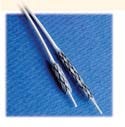April 1, 2003
Originally Published MPMN April 2003
PROFILE
Radiopaque Imprinting Enables Alternative to Angioplasty
Markings on fabric substrate of device allow precise positioning
|
This angioplasty-alternative device from CryoVascular Systems was imprinted with a radiopaque ink from CI Medical that allows precise positioning within a blood vessel. |
For four years, CryoVascular Systems (Los Gatos, CA; www.cryoinc.com) has worked to develop cryotherapy devices, a group of angioplasty-alternative products that revascularize arteries while simultaneously treating them with cold temperatures. This technology would inhibit restenosis and eliminate the need to permanently
implant a stent, but researchers were having difficulty accurately viewing the placement of the cryotherapy catheters under fluoroscopy. Realizing that imprinting the devices witha radiopaque ink could solve this problem, the company turned to CI Medical (Norton, MA; www.cimedical.com) for help.
"The imprinting aspect of this project was vitally important to the product"s eventualsuccess," says Cryo- Vascular Systems project engineer Keith Burger. "Although radiopaque ink had never been imprinted ona fabric layer like the one we use in our device, we knew that CI Medical had extensive experience with these kinds of inks and excelled in solving medical-device-imprintingproblems," he adds.
Specializing in the development of medical-grade inks and imprinting technology, CI Medical was up for the challenge. Noting a growing interest in the use of radiopaque inks in the medical field, the company had developed a special formulation and proprietary imprinting process that allowed it to mark with clarity on numerous substrates, including fabric. Working closely with CryoVascularSystems" design engineers, the company fine-tuned this technology to produce the required imprint size, definition, ink thickness, and opacity.
The resulting product exceeded both companies" expectations. With the device"s fabric layer repeatedly imprinted with tight-tolerance markings, practitioners could easily track the device under fluoroscopy and place it accurately within apatient"s blood vessel. The imprinted pattern, which changes shape when inflated or deflated, also allows them to determine when the device can be removed safely.
Cryotherapy devices from Cryo-Vascular Systems are already commercially available in Europe. The company expects to reach the American market with this technology in the first quarter of 2003. CI Medical is pleased to see its customer doing well and believes it could do the same for others."This is a perfect example of how we can interface with design engineers in the early stages ofdevelopment," says CI Medical engineering manager Bruce Mahan. "Imprinting is often a critical factor for aproduct's success and should be addressed early on in development," he adds.
Copyright ©2003 Medical Product Manufacturing News
You May Also Like



